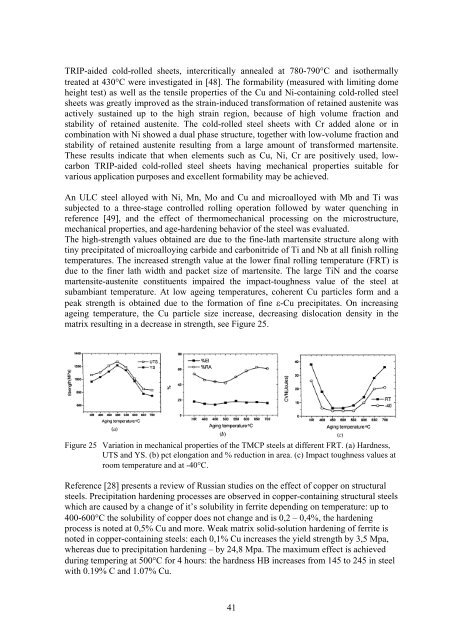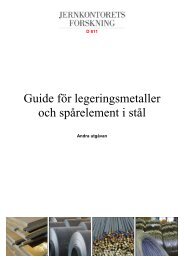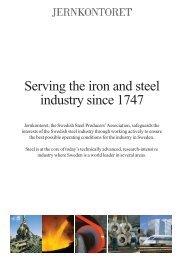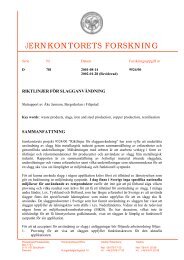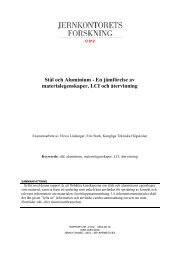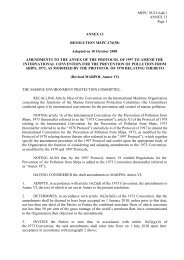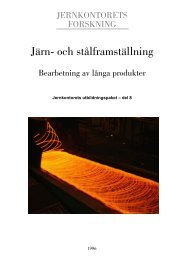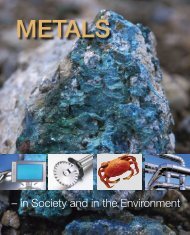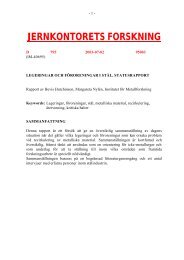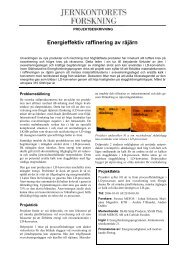Opportunities and dangers of using residual elements ... - Jernkontoret
Opportunities and dangers of using residual elements ... - Jernkontoret
Opportunities and dangers of using residual elements ... - Jernkontoret
Create successful ePaper yourself
Turn your PDF publications into a flip-book with our unique Google optimized e-Paper software.
TRIP-aided cold-rolled sheets, intercritically annealed at 780-790°C <strong>and</strong> isothermallytreated at 430°C were investigated in [48]. The formability (measured with limiting domeheight test) as well as the tensile properties <strong>of</strong> the Cu <strong>and</strong> Ni-containing cold-rolled steelsheets was greatly improved as the strain-induced transformation <strong>of</strong> retained austenite wasactively sustained up to the high strain region, because <strong>of</strong> high volume fraction <strong>and</strong>stability <strong>of</strong> retained austenite. The cold-rolled steel sheets with Cr added alone or incombination with Ni showed a dual phase structure, together with low-volume fraction <strong>and</strong>stability <strong>of</strong> retained austenite resulting from a large amount <strong>of</strong> transformed martensite.These results indicate that when <strong>elements</strong> such as Cu, Ni, Cr are positively used, lowcarbonTRIP-aided cold-rolled steel sheets having mechanical properties suitable forvarious application purposes <strong>and</strong> excellent formability may be achieved.An ULC steel alloyed with Ni, Mn, Mo <strong>and</strong> Cu <strong>and</strong> microalloyed with Mb <strong>and</strong> Ti wassubjected to a three-stage controlled rolling operation followed by water quenching inreference [49], <strong>and</strong> the effect <strong>of</strong> thermomechanical processing on the microstructure,mechanical properties, <strong>and</strong> age-hardening behavior <strong>of</strong> the steel was evaluated.The high-strength values obtained are due to the fine-lath martensite structure along withtiny precipitated <strong>of</strong> microalloying carbide <strong>and</strong> carbonitride <strong>of</strong> Ti <strong>and</strong> Nb at all finish rollingtemperatures. The increased strength value at the lower final rolling temperature (FRT) isdue to the finer lath width <strong>and</strong> packet size <strong>of</strong> martensite. The large TiN <strong>and</strong> the coarsemartensite-austenite constituents impaired the impact-toughness value <strong>of</strong> the steel atsubambiant temperature. At low ageing temperatures, coherent Cu particles form <strong>and</strong> apeak strength is obtained due to the formation <strong>of</strong> fine ε-Cu precipitates. On increasingageing temperature, the Cu particle size increase, decreasing dislocation density in thematrix resulting in a decrease in strength, see Figure 25.Figure 25 Variation in mechanical properties <strong>of</strong> the TMCP steels at different FRT. (a) Hardness,UTS <strong>and</strong> YS. (b) pct elongation <strong>and</strong> % reduction in area. (c) Impact toughness values atroom temperature <strong>and</strong> at -40°C.Reference [28] presents a review <strong>of</strong> Russian studies on the effect <strong>of</strong> copper on structuralsteels. Precipitation hardening processes are observed in copper-containing structural steelswhich are caused by a change <strong>of</strong> it’s solubility in ferrite depending on temperature: up to400-600°C the solubility <strong>of</strong> copper does not change <strong>and</strong> is 0,2 – 0,4%, the hardeningprocess is noted at 0,5% Cu <strong>and</strong> more. Weak matrix solid-solution hardening <strong>of</strong> ferrite isnoted in copper-containing steels: each 0,1% Cu increases the yield strength by 3,5 Mpa,whereas due to precipitation hardening – by 24,8 Mpa. The maximum effect is achievedduring tempering at 500°C for 4 hours: the hardness HB increases from 145 to 245 in steelwith 0.19% C <strong>and</strong> 1.07% Cu.41


